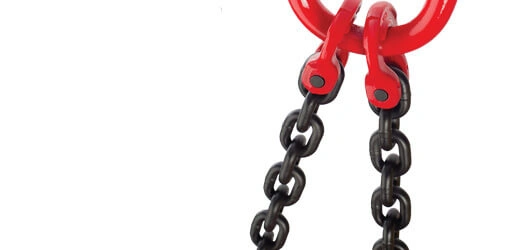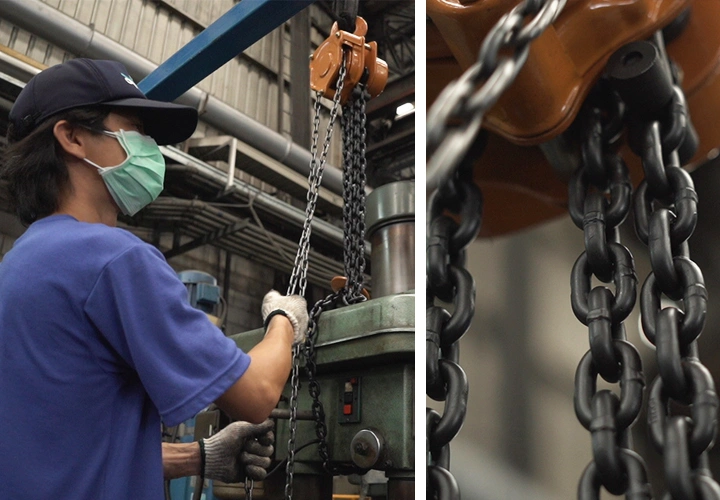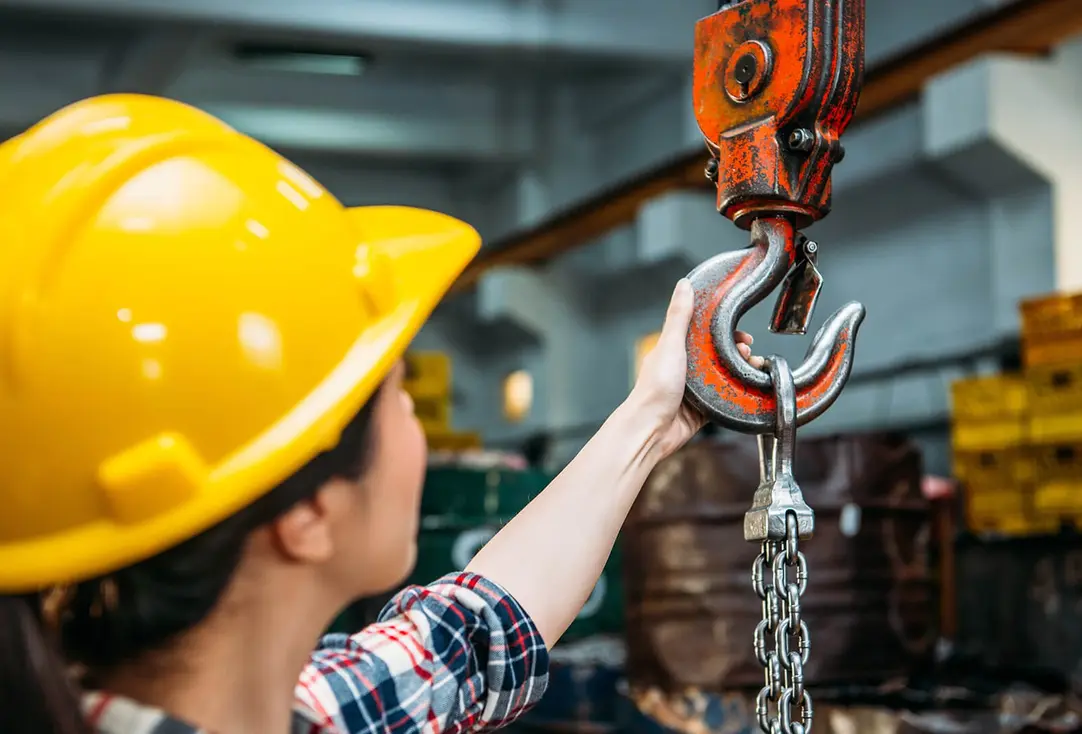Here is a detailed overview of the Chain Safe Working Load of different types of lifting chains, based on common industry standards. Note that the SWL depends on the grade, size, and configuration of the chain. Always verify with manufacturers and local regulations.
Table of Contents
ToggleSome Chain Safe Working Load Capacities
1. GRADE 80 (G80) LIFTING CHAINS
Grade 80 chains are high-strength, heat-treated alloy steel chains used for lifting, rigging, and material handling.
| Chain Diameter (mm) | Chain Diameter (inches) | Safe Working Load (SWL) in Tons (approx.) |
|---|---|---|
| 6 mm | 1/4″ | 1.1 tons (1,100 kg) |
| 8 mm | 5/16″ | 2 tons (2,000 kg) |
| 10 mm | 3/8″ | 3.2 tons (3,200 kg) |
| 13 mm | 1/2″ | 5.3 tons (5,300 kg) |
| 16 mm | 5/8″ | 8 tons (8,000 kg) |
| 20 mm | 3/4″ | 12.5 tons (12,500 kg) |
| 22 mm | 7/8″ | 15 tons (15,000 kg) |
2. GRADE 100 (G100) LIFTING CHAINS
Grade 100 chains have 25% greater lifting capacity than Grade 80 chains, making them ideal for heavy lifting tasks.
| Chain Diameter (mm) | Chain Diameter (inches) | Safe Working Load (SWL) in Tons (approx.) |
|---|---|---|
| 6 mm | 1/4″ | 1.4 tons (1,400 kg) |
| 8 mm | 5/16″ | 2.5 tons (2,500 kg) |
| 10 mm | 3/8″ | 4 tons (4,000 kg) |
| 13 mm | 1/2″ | 6.7 tons (6,700 kg) |
| 16 mm | 5/8″ | 10 tons (10,000 kg) |
| 20 mm | 3/4″ | 16 tons (16,000 kg) |
| 22 mm | 7/8″ | 19 tons (19,000 kg) |
3. GRADE 120 (G120) LIFTING CHAINS
Grade 120 chains offer about 50% more lifting capacity compared to Grade 80 chains, making them suitable for extreme heavy-duty lifting operations.
| Chain Diameter (mm) | Chain Diameter (inches) | Safe Working Load (SWL) in Tons (approx.) |
|---|---|---|
| 6 mm | 1/4″ | 1.6 tons (1,600 kg) |
| 8 mm | 5/16″ | 2.8 tons (2,800 kg) |
| 10 mm | 3/8″ | 4.5 tons (4,500 kg) |
| 13 mm | 1/2″ | 7.5 tons (7,500 kg) |
| 16 mm | 5/8″ | 11.5 tons (11,500 kg) |
| 20 mm | 3/4″ | 18.8 tons (18,800 kg) |
| 22 mm | 7/8″ | 22.5 tons (22,500 kg) |
4. STAINLESS STEEL CHAINS (G30 & G43)
Stainless steel chains are generally used for non-critical lifting, pulling, or marine applications. Their SWL is lower than alloy steel chains.
Grade 30 (G30) Stainless Steel Chains
| Chain Diameter (mm) | Chain Diameter (inches) | Safe Working Load (SWL) in Tons (approx.) |
|---|---|---|
| 6 mm | 1/4″ | 0.4 tons (400 kg) |
| 8 mm | 5/16″ | 0.65 tons (650 kg) |
| 10 mm | 3/8″ | 1 tons (1,000 kg) |
Grade 43 (G43) Stainless Steel Chains
| Chain Diameter (mm) | Chain Diameter (inches) | Safe Working Load (SWL) in Tons (approx.) |
|---|---|---|
| 6 mm | 1/4″ | 0.65 tons (650 kg) |
| 8 mm | 5/16″ | 1 tons (1,000 kg) |
| 10 mm | 3/8″ | 1.5 tons (1,500 kg) |
5. GRADE 70 (G70) TRANSPORT CHAINS
Grade 70 chains are designed for securing loads during transportation and are not typically used for overhead lifting.
| Chain Diameter (mm) | Chain Diameter (inches) | Safe Working Load (SWL) in Tons (approx.) |
|---|---|---|
| 6 mm | 1/4″ | 1.1 tons (1,100 kg) |
| 8 mm | 5/16″ | 2 tons (2,000 kg) |
| 10 mm | 3/8″ | 3.5 tons (3,500 kg) |
| 13 mm | 1/2″ | 5.3 tons (5,300 kg) |
Chain Working Load Limit Chart
The SWL is calculated based on the chain’s diameter and grade. Below is a general guide (values are approximate and can vary by manufacturer):
| Chain Diameter (inches) | Chain Diameter (mm) | Grade 30 SWL (lbs) | Grade 43 SWL (lbs) | Grade 70 SWL (lbs) | Grade 80 SWL (lbs) | Grade 100 SWL (lbs) |
|---|---|---|---|---|---|---|
| 1/4″ | 6.35 | 1,300 | 2,600 | 3,150 | 4,500 | 5,700 |
| 5/16″ | 7.94 | 1,900 | 3,900 | 4,700 | 6,700 | 8,800 |
| 3/8″ | 9.53 | 2,650 | 5,400 | 6,600 | 8,800 | 11,000 |
| 1/2″ | 12.70 | 4,500 | 9,200 | 11,300 | 15,000 | 18,800 |
| 5/8″ | 15.88 | 6,900 | 13,000 | 15,800 | 22,600 | 28,300 |
| 3/4″ | 19.05 | 10,600 | 18,100 | 24,700 | 35,300 | 44,100 |
| 1″ | 25.40 | 18,100 | 30,800 | 39,200 | 53,000 | 66,300 |
Important Notes
- Configuration Matters: The SWL of chains may vary depending on their configuration (e.g., single-leg, double-leg, or multi-leg slings). Always consult sling charts for accurate capacity.
- Inspections: Chains must be regularly inspected for wear, damage, or elongation, as these factors reduce the SWL.
- Standards: Always adhere to national or international standards, such as ISO, OSHA, or ASME B30.9, when selecting and using lifting chains.
Inspection Protocols and Safety Measures for Lifting Chains

Ensuring the safety and reliability of lifting chains requires adherence to strict inspection protocols and safety measures. Below is a detailed guide:
Inspection Protocols
1. Pre-Use Inspection
Before using lifting chains, inspect them thoroughly to identify potential issues. Focus on the following:
- Chain Links: Check for cracks, gouges, wear, or deformities.
- Elongation: Measure the chain length against the manufacturer’s specifications to identify stretching.
- Welding Quality: Ensure no broken or defective welds exist.
- Attachments: Inspect hooks, master links, and other components for wear or damage.
- Surface Condition: Look for rust, corrosion, or signs of excessive heat exposure (e.g., discoloration).
2. Periodic Inspections
Conduct formal inspections at regular intervals based on usage and environmental conditions. Frequency may be:
- Heavy Use: Monthly.
- Moderate Use: Quarterly.
- Light Use: Annually.
Qualified personnel should carry out these inspections to ensure compliance with regulations.
3. Load Testing
Perform load tests on chains after repairs or if a chain’s safety is uncertain. The test should follow the manufacturer’s recommendations or applicable safety standards.
4. Wear Measurement
Check chain links for wear. The common threshold for discard is:
- 10% Reduction in Link Diameter: If the chain diameter reduces by more than 10% from its original size, it must be removed from service.
5. Environmental Factors
- Chains used in harsh environments (e.g., corrosive, chemical, or high-temperature settings) require more frequent inspections.
Safety Measures

1. Selection of Lifting Chains
- Choose chains with an appropriate Grade (G80, G100, G120) for the intended load.
- Ensure the Safe Working Load (SWL) exceeds the weight of the load, including shock forces.
2. Proper Use
- Angle of Lift: Avoid angles below 45° as they reduce lifting capacity.
- Avoid Overloading: Never exceed the chain’s SWL. Use certified load charts to calculate lifting capacities for multi-leg slings.
- Center of Gravity: Ensure the load’s center of gravity is stable and evenly distributed.
3. Environmental Considerations
- Heat Exposure: Avoid using alloy chains in temperatures exceeding their rated limit.
- G80 and G100 chains: Up to 400°C (752°F).
- G120 chains: Up to 300°C (572°F).
- Corrosion: Use stainless steel chains in environments with chemicals or high humidity.
4. Handling and Storage
- Avoid Dragging: Do not drag chains on abrasive surfaces to prevent damage.
- Storage: Store chains in a dry, clean area away from corrosive substances. Hang them to prevent tangling or bending.
5. Training
- Ensure all operators are trained in the proper use, inspection, and maintenance of lifting chains.
- Provide training on interpreting load charts and safe rigging practices.
6. Replacement Guidelines
Replace the lifting chain immediately if:
- Cracks, nicks, or gouges are detected.
- Links show deformation or wear beyond 10% of their diameter.
- Welds are damaged or suspect.
- Stretching or elongation exceeds 3% of the chain’s original length.
Compliance and Standards
- OSHA (Occupational Safety and Health Administration): Adhere to standards like OSHA 1910.184 for slings.
- ASME (American Society of Mechanical Engineers): Follow ASME B30.9 for inspection, use, and maintenance.
- ISO Standards: Comply with ISO 3056 and ISO 4778 for lifting chains.
Checklist for Routine Inspections
| Inspection Task | Pass/Fail | Notes |
|---|---|---|
| Inspect for visible cracks or damage | ||
| Measure link diameter for wear | ||
| Check for chain elongation | ||
| Inspect hooks and master links | ||
| Look for signs of corrosion | ||
| Verify identification tags | Tags should be legible |
A proactive approach to lifting chain inspection and maintenance minimizes risks, prevents accidents, and ensures compliance with safety regulations. Always use certified equipment, maintain proper records, and replace chains when required to safeguard workers and equipment.
Related Posts
How To Avoid Manual Lifting Injuries In The Workplace
Lifting Operation Safety Precautions
Which of the following Personal Protective Equipment must an Employer Pay For?
